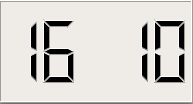Digital Clock Example¶
The Digital Clock example shows how to use QLCDNumber to display a number with LCD-like digits.
This example also demonstrates how QTimer can be used to update a widget at regular intervals.
DigitalClock Class Definition¶
The DigitalClock class provides a clock widget showing the time with hours and minutes separated by a blinking colon. We subclass QLCDNumber and implement a private slot called showTime() to update the clock display:
class DigitalClock(QLCDNumber): Q_OBJECT # public DigitalClock(QWidget parent = None) slots: = private() def showTime():
DigitalClock Class Implementation¶
def __init__(self, parent): QLCDNumber.__init__(self, parent) setSegmentStyle(Filled) timer = QTimer(self) connect(timer, QTimer.timeout, self, DigitalClock.showTime) timer.start(1000) showTime() setWindowTitle(tr("Digital Clock")) resize(150, 60)
In the constructor, we first change the look of the LCD numbers. The Filled style produces raised segments filled with the foreground color (typically black). We also set up a one-second timer to keep track of the current time, and we connect its timeout() signal to the private showTime() slot so that the display is updated every second. Then, we call the showTime() slot; without this call, there would be a one-second delay at startup before the time is shown.
def showTime(self): time = QTime.currentTime() text = time.toString("hh:mm") if ((time.second() % 2) == 0) text[2] = ' ' display(text)
The showTime() slot is called whenever the clock display needs to be updated.
The current time is converted into a string with the format “hh:mm”. When second() is a even number, the colon in the string is replaced with a space. This makes the colon appear and vanish every other second.
Finally, we call display() to update the widget.
© 2022 The Qt Company Ltd. Documentation contributions included herein are the copyrights of their respective owners. The documentation provided herein is licensed under the terms of the GNU Free Documentation License version 1.3 as published by the Free Software Foundation. Qt and respective logos are trademarks of The Qt Company Ltd. in Finland and/or other countries worldwide. All other trademarks are property of their respective owners.

